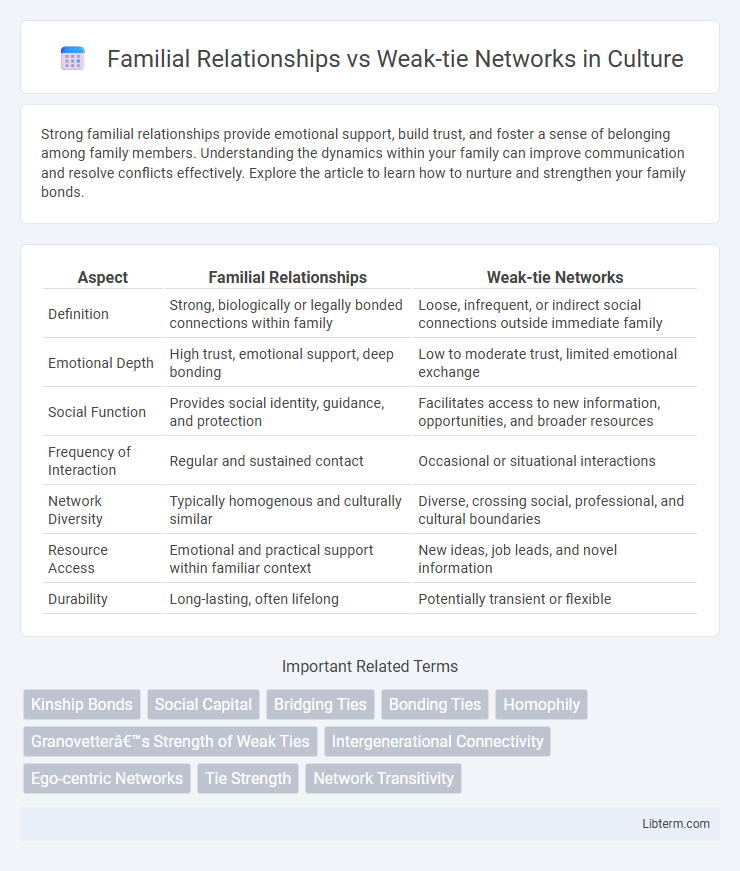Strong familial relationships provide emotional support, build trust, and foster a sense of belonging among family members. Understanding the dynamics within your family can improve communication and resolve conflicts effectively. Explore the article to learn how to nurture and strengthen your family bonds.
Table of Comparison
| Aspect | Familial Relationships | Weak-tie Networks |
|---|---|---|
| Definition | Strong, biologically or legally bonded connections within family | Loose, infrequent, or indirect social connections outside immediate family |
| Emotional Depth | High trust, emotional support, deep bonding | Low to moderate trust, limited emotional exchange |
| Social Function | Provides social identity, guidance, and protection | Facilitates access to new information, opportunities, and broader resources |
| Frequency of Interaction | Regular and sustained contact | Occasional or situational interactions |
| Network Diversity | Typically homogenous and culturally similar | Diverse, crossing social, professional, and cultural boundaries |
| Resource Access | Emotional and practical support within familiar context | New ideas, job leads, and novel information |
| Durability | Long-lasting, often lifelong | Potentially transient or flexible |
Introduction to Familial Relationships and Weak-Tie Networks
Familial relationships are strong-tie social connections characterized by frequent interactions, emotional support, and shared history, often forming the core of individuals' social networks. Weak-tie networks consist of more casual, less frequent interactions that provide access to novel information and diverse resources beyond immediate social circles. Understanding the distinctions between these relationships highlights their complementary roles in social capital and information flow.
Defining Familial Relationships: Bonds and Boundaries
Familial relationships are defined by strong emotional bonds, shared history, and clear boundaries that establish roles and responsibilities among family members. These connections typically involve high trust, frequent interactions, and a deep sense of obligation, distinguishing them from weaker social ties. Boundaries within familial relationships help maintain stability and identity, often guiding communication patterns and conflict resolution strategies.
Understanding Weak-Tie Networks: Beyond Close Circles
Weak-tie networks expand social connections beyond close familial relationships, enabling access to diverse information and resources not typically available within tight-knit groups. These networks often link individuals from different social circles, enhancing opportunities for innovation, job searches, and social mobility through indirect acquaintances. Understanding the dynamics of weak-tie networks is crucial for leveraging social capital and fostering connectivity across broader communities.
Emotional Support: Family vs Weak-Tie Connections
Familial relationships provide strong emotional support through deep bonds, consistent interactions, and shared history, fostering trust and empathy. Weak-tie networks offer diverse perspectives and novel information, but emotional support is typically less intense and less reliable than family connections. The emotional resilience found in family ties contrasts with the broader resource access gained from weak-tie networks.
Information Flow: The Power of Weak Ties
Weak-tie networks facilitate faster and more diverse information flow compared to familial relationships, as they bridge different social groups and provide access to novel resources. Granovetter's theory highlights that weak ties act as crucial connectors, enabling individuals to gather unique insights beyond their immediate family circle. This expansive reach of weak ties enhances innovation and opportunity discovery, outperforming the redundancy often found within tightly-knit family networks.
Trust and Reliability in Familial Bonds
Familial relationships exhibit high levels of trust and reliability, stemming from long-term emotional connections and shared histories that foster deep mutual understanding. These bonds provide consistent support and dependable communication, often surpassing the transactional nature of weak-tie networks characterized by casual or situational interactions. Trust in familial ties is reinforced by social norms and obligations, making these networks more resilient during times of crisis compared to weak-tie connections.
Opportunity Access: Social Capital in Weak Networks
Weak-tie networks expand opportunity access by connecting individuals to diverse social circles beyond their immediate familial relationships, enhancing social capital through broader information flow and resource exchange. Unlike strong familial ties that often involve redundant connections, weak ties introduce novel opportunities and bridge structural holes in social networks. Access to weak-tie networks correlates with increased job prospects, innovation diffusion, and social mobility due to the heterogeneity of contacts and informational advantages they provide.
Challenges and Limitations of Each Network Type
Familial relationships often face challenges such as emotional bias, limited diversity in perspectives, and potential conflicts impacting decision-making or support systems. Weak-tie networks, while offering broader access to diverse information and opportunities, can suffer from lower trust levels and less frequent interaction, reducing the strength of support. Both network types have limitations in balancing intimacy and reach, affecting their effectiveness in different social or professional contexts.
Balancing Family and Extended Social Networks
Balancing familial relationships and weak-tie networks requires managing strong, trust-based bonds alongside broader connections that offer diverse resources and opportunities. Familial ties provide emotional support and stability, while weak-tie networks facilitate access to novel information and social mobility. Successful social navigation involves maintaining close family interactions without neglecting the benefits of expansive, less intense relationships.
Conclusion: Integrating Strong and Weak Ties for Success
Balancing familial relationships and weak-tie networks creates a robust support system that enhances personal and professional success. Strong ties provide trust and emotional backing, while weak ties offer diverse information and new opportunities. Integrating both types of connections enables individuals to leverage deep loyalty alongside broad access to resources and innovation.
Familial Relationships Infographic

 libterm.com
libterm.com